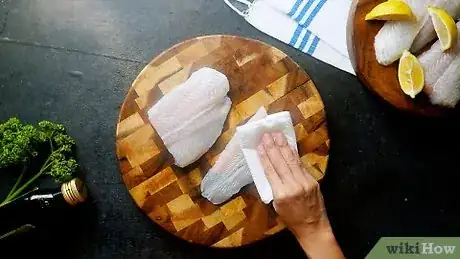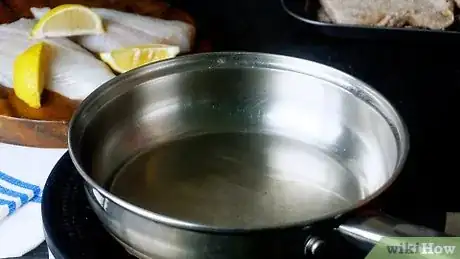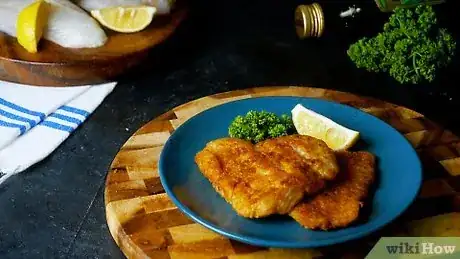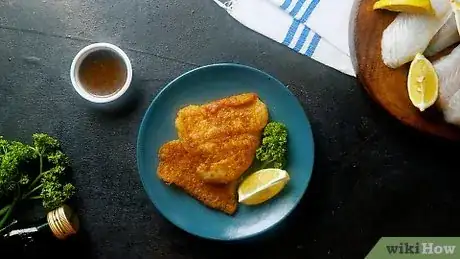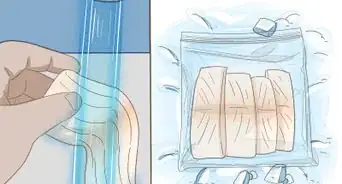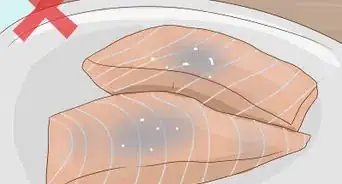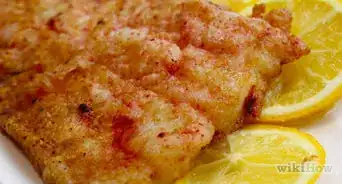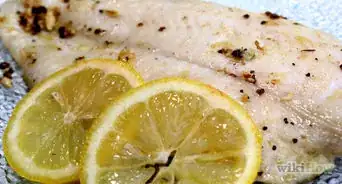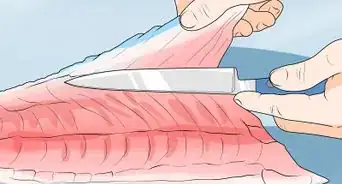This article was co-authored by Elsie Glasu-Atunuwa. Elsie Glasu-Atunuwa is a West African Chef and the Founder of Trices Cafe and Lounge in San Antonio, Texas. Elsie learned to cook from her mother, using only the finest ingredients to create great flavors. Her mother’s training and her own imagination allow her to create delicious traditional West African dishes to satisfy customers, friends, family, and colleagues. Her team specializes in serving dishes from Nigeria, Ghana, and Cameroun. They also offer catering for all occasions. Elsie studies General Science and holds a doctorate degree in Nursing from Grand Canyon University.
There are 8 references cited in this article, which can be found at the bottom of the page.
This article has been viewed 34,424 times.
Pan-frying fish fillets is quick and requires very few ingredients. Once the fillets are seasoned with herbs, spices, or breading, it only takes a few minutes to cook them in a skillet with oil. Garnish the fried fillets with minced herbs and lemon juice, or whip together a quick dipping sauce. After pan-frying your first set of fillets, you will find the process is simple and leaves room for you to experiment with different seasonings.
Ingredients
- 2 fish fillets (5 oz (140 g) and 1⁄2 in (1.3 cm) thick)
- Salt and ground black pepper to taste
- 1/4 cup (32 g) of all-purpose or whole-wheat flour
- 1 tsp (2.1 g) of sweet or hot paprika
- 1 1⁄2 tablespoons (22 mL) of vegetable or canola oil
- 1 1/2 tsp (3.15 g) of Cajun seasoning (optional)
- 1 tsp (2.1 g) of lemon pepper (optional)
- 1/4 tsp (0.78 g) of onion powder (optional)
- 1/4 tsp (0.78 g) of garlic powder (optional)
- Lemon zest or juice to taste (optional)
- Minced herbs like parsley, thyme, dill, oregano, or cilantro to taste (optional)
Yields 2 servings
Lemon Butter Sauce
- 3 tbsp (42.6 g) of salted butter
- 1 1⁄2 US tbsp (22 mL) of lemon juice
Tartar Sauce
- 1⁄3 cup (79 mL) of mayonnaise
- 2 tsp (9.9 mL) of lemon juice
- 2 tbsp (8.9 g) of minced dill pickles
- Salt and ground black pepper to taste
Steps
Seasoning the Fillets
-
1Pat the outside of 2 fish fillets dry using a paper towel. Select fillets that each weigh approximately 5 oz (140 g) and are 1⁄2 in (1.3 cm) thick. Place them on a clean plate, then gently pat each side of the fillets with paper towels until the fillets are completely dry. This is especially important if you are breading your fillets, as it will make the breading soggy.[1]
- If you are using frozen fillets, make sure to defrost them on a plate overnight in the refrigerator. The fillets must be completely defrosted before you can season and pan-fry them.
- If you are using a fresh or whole fish, make sure to remove all of the pin bones and scales while filleting.
- Pick a type of fillet that you enjoy eating the most. Red snapper, salmon, sea bass, and tilapia are common types of fillets to pan fry because the meat cooks quickly and the skin—if left on—holds a lot of flavors.[2]
- Choose fillets with or without the skin, as both work well for pan-frying. Just avoid using types of fish that have tough, chewy skin, like tuna or swordfish.
-
2Season unbreaded fillets with herbs and spices before frying them. Mix together some of your favorite seasonings, making sure to include salt and pepper to taste. Sprinkle and rub the seasoning mixture onto each side of both fillets. Then, rest the fillets on a clean plate.[3]
- Keep the seasoning simple by only using a rub of salt and ground black pepper to taste.[4]
- Coat your fillets in 1 1/2 tsp (3.15 g) of Cajun seasoning for a quick, spicy seasoning.
- Create tangy seasoning with 1 tsp (2.1 g) of lemon pepper, minced thyme, and lemon zest to taste.
- You can also use onion powder, ginger powder, or garlic powder for a more dynamic flavor.
Advertisement -
3Give your fillets a crispy texture by breading them with seasoned flour. Create a breading by mixing together 1/4 cup (32 g) of flour, 1 tsp (2.1 g) of sweet or hot paprika, and salt and pepper to taste on a plate. Coat each side of both fillets with the seasoned flour, and use your fingers to press the fillet into the mixture so it evenly adheres. Then, gently shake off the excess flour on the fillets and rest them on a clean plate. This will help create a thin coating that will brown evenly when fried.[5]
- Refrain from over-packing the fillets to create a thick crust. Thick crusts will not only fall off while cooking but will also cook unevenly.
- Transform the flavor of the breading mixture by incorporating additional herbs and spices. For example, consider adding a 1/4 tsp (0.78 g) of onion powder, garlic powder, thyme, and oregano for a tangy, earthy flavor, or mix in some cornmeal with the flour to give the coating a grittier texture.[6]
Frying the Seasoned Fish
-
1Preheat a skillet over medium-high heat on your stovetop. Allow the pan to heat for 1-2 minutes or until you see visible heat waves coming off the pan. Heating the pan before adding the oil will help keep the crust of the fillet from sticking to the bottom of the pan.[7]
- Use a cast iron skillet or non-stick frying pan to cook your fillets.[8]
-
2Pour 1 1⁄2 US tbsp (22 mL) of oil into the skillet to heat it. Carefully add your vegetable or canola oil into the hot skillet. Tilt your pan as needed to coat the entire bottom of the skillet.[9]
- Add an additional 1⁄2 US tbsp (7.4 mL) of oil if needed to coat the base of the skillet.
- If you don’t want to use oil, you can use butter for a more succulent flavor.
-
3Cook each side of the fillets for 2 minutes over medium-high heat. Use heat-resistant tongs or a heat-resistant spatula to handle the fillets while cooking in the pan. Once the first side has cooked for 2 minutes, flip the fillets over and allow the second side to cook for another 2 minutes. When finished, the outside of the fillets will be crispy, and the breading, if used, will have a golden-brown coloring. [10]
- Thicker fillet cuts make take more time to cook, usually about 3-4 minutes on each side.[11]
- If your fillets have skin on them, then place the skin side down to cook first.[12]
- Avoid coating your kitchen and yourself with pops of hot oil by covering your skillet with a splatter screen. Purchase a splatter screen in the kitchen section of your local department store or online with major retailers.
-
4Place the finished fillets onto a heat-resistant plate lined with a paper towel. Use your tongs or spatula to gently rest the fillets onto a plate covered with a paper towel. Gently pat the fillets with an additional paper towel to remove any unwanted grease. Then, discard the greasy paper towels.[13]
- Refrain from leaving the paper towels underneath the fillets for more than 30-60 seconds, as the moisture trapped within the paper towel will make the crispy fillets soggy.
Serving and Garnishing the Pan-Fried Fillets
-
1Serve the warm fillets plain or top them with additional garnishes. If needed, allow your fillets to rest for 1-2 minutes before serving, as the fillets may be too hot to eat. Then, enjoy eating your pan-fried fillets as is, or include your favorite garnishes, like lemon juice or minced parsley, to elevate the flavors.[14]
-
2Dip your pan-fried fillets into a homemade lemon butter sauce for a tart flavor. Combine 3 tbsp (42.6 g) of salted butter and 1 1⁄2 US tbsp (22 mL) of lemon juice in a small saucepan over a medium-low heat. Stir the mixture continuously and allow it to simmer for 3 minutes so it thickens. Remove it from the heat and serve on the side.[15]
-
3Whip together a tangy tartar sauce to serve on the side of your fillets. Mix together 1⁄3 cup (79 mL) of mayonnaise, 2 tsp (9.9 mL) of lemon juice, 2 tbsp (8.9 g) of minced dill pickles, and salt and ground black pepper to taste. Then, serve the sauce on the side and dip pieces of your crispy fillet into it.[16]
-
4Serve malt vinegar on the side of your fillets to use as a simple dipping sauce. Pour 1–2 tablespoons (15–30 mL) of malt vinegar into a small bowl to accompany your fillets. Dip pieces of your fillet into the vinegar and enjoy![17]
- The bitter and bold taste of malt vinegar is a classic, simple dipping sauce for pan-fried fillets. Just know that a little bit of the vinegar goes a long way, so dip your fillets conservatively.
-
5Refrigerate any leftovers in a sealable container for about 3-4 days. Keep in mind that the refrigerator will add moisture to any breading on the fillets and make it soggy. Consider eating the pan-fried fillets immediately after frying to avoid this.[18]
Things You’ll Need
- Paper towels
- Measuring cups and spoons
- 4 heat-resistant plates
- Cast iron skillet or a non-stick frying pan
- Heat-resistant tongs or spatula
- Splatter screen (optional)
References
- ↑ https://www.recipetineats.com/crispy-pan-fried-fish/
- ↑ https://www.saveur.com/article/techniques/how-to-pan-fry-fish
- ↑ https://www.myrecipes.com/recipe/natalies-cajun-seasoned-pan-fried-tilapia
- ↑ https://www.foodnetwork.com/recipes/pan-fried-fish-recipe-1910675
- ↑ https://www.recipetineats.com/crispy-pan-fried-fish/
- ↑ https://www.southernliving.com/food/how-to/how-to-pan-fry-fish?slide=64316#64316
- ↑ https://www.recipetineats.com/crispy-pan-fried-fish/
- ↑ https://www.saveur.com/article/techniques/how-to-pan-fry-fish
- ↑ https://www.foodnetwork.com/recipes/pan-fried-fish-recipe-1910675
- ↑ https://www.recipetineats.com/crispy-pan-fried-fish/
- ↑ https://www.myrecipes.com/recipe/natalies-cajun-seasoned-pan-fried-tilapia
- ↑ https://www.saveur.com/article/techniques/how-to-pan-fry-fish
- ↑ https://www.foodandwine.com/news/perfect-pan-fried-fish-greek-style
- ↑ https://www.bhg.com/recipes/fish/basics/how-to-fry-fish/
- ↑ https://www.recipetineats.com/crispy-pan-fried-fish/
- ↑ https://www.recipetineats.com/crispy-pan-fried-fish/
- ↑ https://www.bhg.com/recipes/fish/basics/how-to-fry-fish/
- ↑ https://www.fda.gov/downloads/food/resourcesforyou/healtheducators/ucm109315.pdf
- ↑ https://www.recipetineats.com/crispy-pan-fried-fish/
About This Article
To pan fry fish, start by seasoning the fillets with herbs and spices or breading. Then, preheat a skillet over medium-high heat for a couple minutes before adding some oil. Next, add the fillets to the pan, and cook them for 2 minutes on each side or until the outside of the fish is crispy. Finally, transfer the fish to a plate lined with a paper towel to remove any excess grease. To learn how to serve and garnish pan-fried fish, scroll down!
